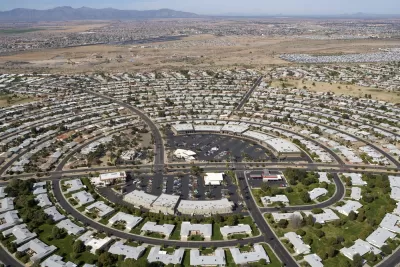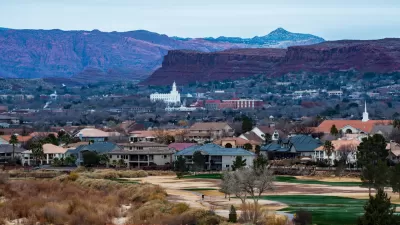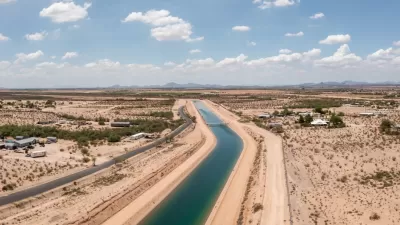New communities are popping up across Arizona’s desert, evading water consumption restrictions and straining the state’s groundwater supplies.

Reporting for KJZZ, Katherine Davis-Young examines Arizona’s increasingly urgent water crisis. As Davis-Young explains, “Maricopa County’s population has more than doubled over the past 30 years, making it one of the fastest growing regions in the country. But meanwhile, Arizona’s water supply has become more and more depleted.”
The 1980 Groundwater Management Act called on the state to use underground aquifers primarily as a back-up and employ tactics to replenish groundwater supplies, but Kathleen Ferris, a researcher from Arizona State University, says that has not been happening.
“In most areas of central Arizona, a developer can’t build a new home without first proving that there’s enough water to last that property 100 years. But there are loopholes for larger lots in rural areas, like many homes in Rio Verde Foothills.” And while some cities like Phoenix have actually reduced their water use even as their population grew, rapid development happening in undeveloped desert areas largely counts on groundwater. “Back in 1980, legislators set a target to achieve safe yield of groundwater by 2025. So Ferris thinks the time for elected leaders to start answering questions about growth and sustainability is now.”
More Planetizen coverage of the water crisis in the American West:
FULL STORY: Arizona's water supply is shrinking, but its population is growing. Is it sustainable?

Study: Maui’s Plan to Convert Vacation Rentals to Long-Term Housing Could Cause Nearly $1 Billion Economic Loss
The plan would reduce visitor accommodation by 25,% resulting in 1,900 jobs lost.

North Texas Transit Leaders Tout Benefits of TOD for Growing Region
At a summit focused on transit-oriented development, policymakers discussed how North Texas’ expanded light rail system can serve as a tool for economic growth.

Why Should We Subsidize Public Transportation?
Many public transit agencies face financial stress due to rising costs, declining fare revenue, and declining subsidies. Transit advocates must provide a strong business case for increasing public transit funding.

How to Make US Trains Faster
Changes to boarding platforms and a switch to electric trains could improve U.S. passenger rail service without the added cost of high-speed rail.

Columbia’s Revitalized ‘Loop’ Is a Hub for Local Entrepreneurs
A focus on small businesses is helping a commercial corridor in Columbia, Missouri thrive.

Invasive Insect Threatens Minnesota’s Ash Forests
The Emerald Ash Borer is a rapidly spreading invasive pest threatening Minnesota’s ash trees, and homeowners are encouraged to plant diverse replacement species, avoid moving ash firewood, and monitor for signs of infestation.
Urban Design for Planners 1: Software Tools
This six-course series explores essential urban design concepts using open source software and equips planners with the tools they need to participate fully in the urban design process.
Planning for Universal Design
Learn the tools for implementing Universal Design in planning regulations.
City of Santa Clarita
Ascent Environmental
Institute for Housing and Urban Development Studies (IHS)
City of Grandview
Harvard GSD Executive Education
Toledo-Lucas County Plan Commissions
Salt Lake City
NYU Wagner Graduate School of Public Service





























